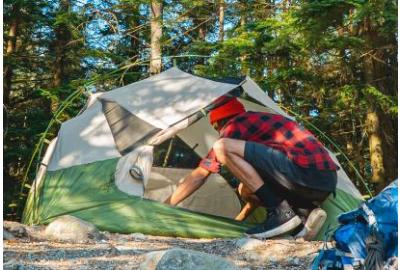Pitch a Tent, Not a Fit - Pro Tips on Where to Set Up Your Tent
We’ve taken out all the guesswork in where to set up your tent when your destination is the backcountry! I’ve consulted with both Brad (our in-house outdoor expert) and the Scouting America Fieldbook to pull together all the best tips for picking the perfect place to pitch your tent while on your outdoor adventures (psst… still hunting for yourbest tent? Check out this tent guide!).
I found a recurring theme that threads throughout all of these best practices in selecting the ideal campsite – the Leave No Trace principles. They lay the groundwork for most of these best practices.
- Plan your route and check state laws and regulations for setting up camp and building campfires. Some areas have a ban on fires depending on what is going on environmentally.
- Use a pre-built firepit or established fire ring, where accessible. Just like above, it is important to minimize campfire impacts (the 5th Leave No Trace principle). If there is no previously made fire area, follow the rest of the Leave No Trace points – keep your fire small, burn it all down before you leave and then scatter the cool ashes, and remove any partially burned trash. Avoid campfires completely unless you can remove all traces!
- If it is available, choose a pre-made campsite. The second principle of Leave No Trace states to, “Travel and camp on durable surfaces.” This will help keep our gorgeous wildlife areas pristine for generations to come.
- Select flat ground, preferably where there is some soft ground cover like pine needles. This will not only give your tent some cushion, but also add a little more comfort to your sleeping situation and can help to prevent erosion! If you cannot find totally flat ground, choose the area with the least amount of slope and be sure to set up your sleeping bag to where your head will be above your feet – perpendicular to the slope – so you don’t roll away or slide while you are sleeping.
- This one may be obvious, but don’t set up on cliffs or loose rocks. Again, the last thing you want is to experience the sensation of your tent moving with you in it. It is dangerous and can also have a negative impact on the environment (and not to mention your tent).
- Avoid setting up in close proximity to dead fall or underneath widow makers. …I had no idea what those terms were at first, either. Basically, you should not pitch a tent under a dead tree or in the middle of an area with fallen trees. Typically, if there is a cluster of fallen trees, it is indicative of soft ground and there is a higher possibility that more branches or trees could come down.
BUT, these are good areas to set up near because those dead branches make the perfect firewood! - Resist the temptation to camp out in a wide-open area. The views are great, yes, but it is important to always operate with a safety-first mindset. Choose a spot with some sort of land structure to help protect you and your campsite from the elements. It is also important to avoid setting up next to a lone tree (hi, lightning rod), or on the tippy top of a hill or mountain (again, don’t make your campsite a lightning target).
- Put up your tent where water is easily accessible, but not right next to the water. A good rule of thumb is to set up at least 200 feet away from water (be sure to check with your local state and park regulations for more location-specific guidelines), and this is important for a variety of reasons.
- Cold air is trapped near the water, so if you are camping in cooler weather, this will help give you a little more warmth.
- Animals come to water to drink at night and you do not need to be between any wild animal and their water stop.
- Flash flooding. Look for water trails – where dirt and leaves have been washed out (that flat and bare bit of land by the water looks great, but if it starts raining, you could get flash flooded out and end up in a little creek!).
- It protects the water source from human contaminants
- Speaking of water, be sure to look around at drainage patterns. Keep away from setting up where there is washout (leaves and the dirt pattern is a good solid indicator). The tent should be placed in a position that allows water to drain away from the tent, so that you don’t have a river running through it.
- Set up your tent away from where you are going to be eating. Brad brought up a great point. Pretend that you have a dining room for eating and then your tent is your bedroom for sleeping. That way, if you’re camping in a region with bears, you can hang your bear bag close to the dining room, away from where you are sleeping.
- If you are camping in the snow, clear the ground of snow before setting up your tent. Snow can make it harder to anchor the tent (depending on how thick the layer is!) and removing the snow can also keep things just a little warmer (and hey – every little bit counts!).


As you are creating your plan for backpacking off the grid, be sure to always be conscious of living the Outdoor Code when you are choosing your campsite. The Outdoor Code is the Scouting America’s guide for outdoor ethics and covers everything from being clean and courteous in the outdoors to being conservation-minded. At the end of the day, all of the pro tips around choosing that ideal tent spot circle back to us being environmentally conscious and safe!

















